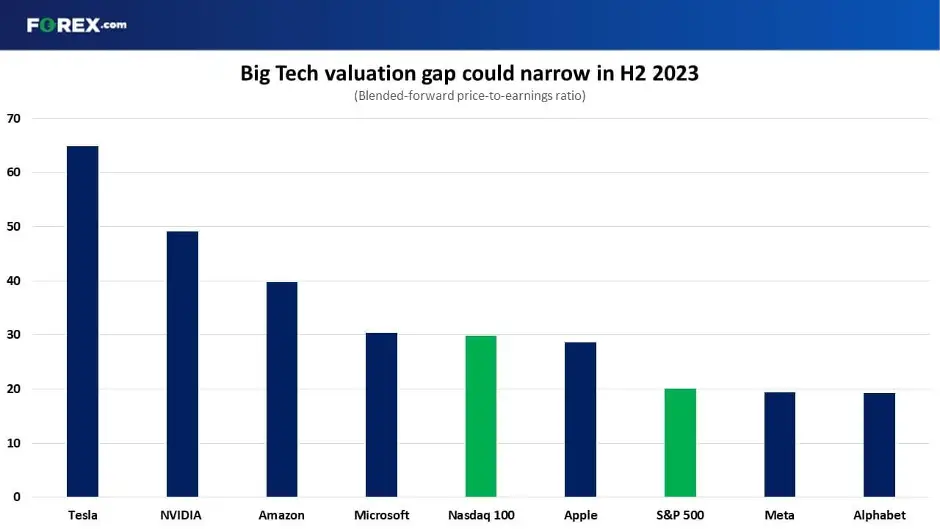Apple vs. Tesla: Where "Tech Giant" Stock Will Stand in Q4

The first half of the year we saw tech stocks taking the spotlight, with Apple, Amazon, Meta, Microsoft, and Tesla outperforming the wider market and proving themselves as the propellant pushing both indices to their highest level in more than a year.
Interested in how big tech is going during the second half of 2023 as we head into Q4, the experts at FOREX.com took a deeper dive into this.
The results: Big Tech valuation gap could narrow in H2 2023

As we step into the second half of 2023, the global financial landscape remains dynamic, promising both challenges and opportunities for investors. What we can expect for the coming months:
Tech stocks revival continues
Big tech companies saw a great revival in the first half of the year, with Apple, Alphabet, Amazon, Meta, Microsoft, NVIDIA, and Tesla leading the way. Their performance propelled both the Nasdaq 100 and the S&P 500 to new heights, reflecting the tech sector’s ability to adapt in uncertain times.
However, as we progress into the last quarter, big tech companies face the test of maintaining and sustaining growth. The diversity in valuations among these tech giants will likely narrow, creating opportunities for long term investors and traders.
Tech valuations have tempered during the pullback we have seen since the start of August, with the price-to-earnings ratio of the Nasdaq 100 declining from over 30 in July and closer toward 25 today. All seven companies have seen their valuation multiples drop over the past three months, with those with the highest ratios like NVIDIA and Tesla underperforming and experiencing the sharpest declines, and the wide range among the group has narrowed.
Some stocks, such as NVIDIA, have seen their multiples return to more normal levels but some still look expensive when considering the troublesome outlook and their historic averages, like Tesla.
Apple and Meta were both trading at higher than usual valuations heading into this earnings season but are now trading below their 5-year average. All-in-all, the range of valuations in the group has narrowed in recent months but remains wide, suggesting there are still some offering attractive multiples and others that still have room to come down further.
Earnings expectations
The expectations for earnings growth in the tech sector varies among companies. Amazon and NVIDIA, which are known for high valuations, are expected to deliver strong growth, while Apple and Microsoft exhibit more cautious forecasts. Alphabet and Meta fall in between, with potential for higher valuations in the latter half of the year. These differing outlooks are reflective of the challenges and opportunities present in the ever-changing tech landscape.
We’ve had results out from Tesla, Microsoft, Alphabet, Meta and Amazon so far and it has been a mixed bag. Generally speaking, the group beat expectations, but this was tempered by a more cautious outlook given the high level of economic and geopolitical uncertainty lingering over the horizon.
Microsoft and Amazon both impressed thanks to their diverse business models and cloud-computing arms that are positioned to benefit from AI. Meta and Alphabet disappointed as markets fret over the outlook for advertising in 2024 and their ability to capitalize on new technology, while Tesla is being hurt by a combination of slower growth and tighter margins.
As for those yet to come, the bar looks far lower for NVIDIA today than a few months ago, which bodes well for Wall Street’s favourite AI stock, while the jury is out ahead of Apple’s update as concerns grow about demand for the iPhone 15 and other hardware.
Artificial intelligence’s role
AI has emerged as a defining technology in the big tech sector. Unlike some previous trends (Metaverse to NFTs) that generated hype but had limited applications in the real world, AI is here to stay with practical and tangible solutions. While its trajectory may be a bit of a roller coaster for traders as initial winners pull back and new entrants rise, it presents long term investment opportunities.
AI Market Expert at FOREX .com , Matt Weller, says:
“Big tech’s influence on the financial markets is expected to remain strong in the second half of 2023. Investors are advised to stay vigilant and adapt to ever changing dynamics. Tech stocks typically outperform in good economic conditions but face challenges during downturns, and this trend is likely to continue.
As we move towards the end of 2023, investors are encouraged to remain flexible, assess risk reward profiles carefully and consider broader economic context when making investment decisions. The landscape may have changed dramatically in the past year, but big tech’s enduring size and resilience make it a compelling sector to watch, especially as conditions improve.”
The remainder of 2023 promises to be an intriguing journey for investors, big tech will continue to play a crucial role in shaping the fate of financial markets with unique opportunities and challenges ahead.
Joshua Warner, Market Analyst at FOREX .com, comments on how Q4 is looking so far:
“There are reasons to be cautiously upbeat about Big Tech as we head into the final quarter of the year, but markets are becoming increasingly pessimistic about what lies around the corner in 2024 as higher-for-longer interest rates, persistent inflation and a strong but weakening economy all play out.
The bears have made their presence known in recent months but still have more work to do before they push the bulls out entirely. The landscape for equities has become murkier, visibility is more limited and there are attractive opportunities elsewhere now that treasury yields have spiked to 16-year highs.
The valuation gap among the group of seven Big Tech members means there are challenges and opportunities ahead. Those with the lowest multiples that trade at a discount will become the most attractive when conditions finally improve, while some may have a tougher time justifying their valuations as the outlook becomes increasingly challenging.”




















